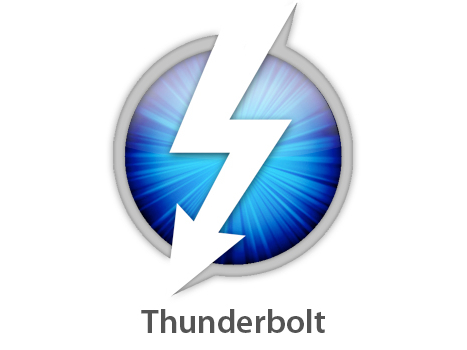Intel Says Thunderbolt Optical Cables Coming This Year
Intel has confirmed that optical cables for Thunderbolt will be released later this year.
Intel spokesman Dave Salvator has reportedly confirmed to IDG News that the company will release optical cables for Thunderbolt later this year. Unlike the copper-based versions, these should provide more bandwidth and longer cable runs in the near future.
Co-developed by Apple, Thunderbolt was originally designed as a faster alternative to USB 3.0 using fiber optics to transfer data at speeds of up to 10 Gbps. First introduced back in 2009 and then launched on Apple Macs in 2011, Intel wanted to reduce the number of ports on a PC and Mac by running all data transfers, networking and display protocols (including DisplayPort) through a single optical port. It would even support PCI-Express 2.0 for connecting external devices.
Current Thunderbolt devices share a common connector, meaning they can all be daisy-chained one after another by connecting copper-based and the upcoming optical cables. But until this year, fiber optics has been far too expensive for the general consumer, thus the two companies decided to settle on a cheaper copper solution for the immediate future. The copper solution thus is now able to provide up to 10 watts of power, but can only pump data across six meters at the most.
But according to Salvator, the upcoming optical cables will allow transfers across "tens of meters," yet devices will need their own power supply at greater lengths, as running power over longer optical cable will cause a impedance-induced power drop and thus be impractical. However optical cables will allow for more bandwidth as the technology develops, so that's a plus.
Current Thunderbolt installations in Apple Macs are based on copper, but they will still be compatible with the fiber optic cables launching later this year. For consumers, this means they will be able to purchase existing Thunderbolt products on the market and switch over to optical cables without having to make hardware changes to their current rig.
Current Thunderbolt circuitry ensures that the cables are transparent to copper or fiber optics connections, but the technology could get expensive once it moves to all-optical. Jim McGregor, chief technology strategist at In-Stat, believes this could stymie its adoption -- right now it's still a "niche technology." Thunderbolt really won't make a dent in the way consumers function until it's integrated into handsets, camera, MP3 players and more, he said.
Still, given that the industry is trying to shift over to an all-wireless desktop, Thunderbolt may be locked down to specific needs like adding an external GPU or something similar. Thunderbolt hasn't even arrived on the PC platform as of this writing, but it's expected to make a debut sometime this year from the likes of Lenovo and a handful of other PC manufacturers.
Get Tom's Hardware's best news and in-depth reviews, straight to your inbox.

Kevin Parrish has over a decade of experience as a writer, editor, and product tester. His work focused on computer hardware, networking equipment, smartphones, tablets, gaming consoles, and other internet-connected devices. His work has appeared in Tom's Hardware, Tom's Guide, Maximum PC, Digital Trends, Android Authority, How-To Geek, Lifewire, and others.
-
joytech22 Kinda surprising that motherboard manufacturers haven't released a board with Thunderbolt yet.Reply
I mean.. Technically you spend tons to get the best of the best and if your missing out on something then your really not getting it.
Still, many of us here don't even have a need for Thunderbolt or AMD's alternative Lightningbolt.
It's always nice to have just in case.
By the way.. If it supports PCI-E 2.0 then there should be external GPU enclosures arriving (Obviously externally powered) so you can boost GPU performance on upcoming laptops, which would be ESPECIALLY welcomed on Ultrabooks. -
chuckydb joytech22 If it supports PCI-E 2.0 then there should be external GPU enclosures arriving (Obviously externally powered) so you can boost GPU performance on upcoming laptops, which would be ESPECIALLY welcomed on Ultrabooks.Reply
I think that is a goal in the long term, but the probem right now is that Thunderbold still isn't fast enough!!!!
Mabey once it's PCie 3.0, but I don't think it's soon!!!!
-
Belardo PCIe 2.0 is fast enough.... oh, you are being silly!Reply
yeah, that would make notebooks far more powerful... a $50~100 external PCIe box can come out. -
shardey This cable will be handy when the Thunderbolt to PCIe graphics cards become cheaper.. Wait, we are talking about Thunderbolt, cheap shouldn't be in the same sentence.Reply -
phatboe Thunderbolt has the bandwidth to run external video cards. The problem is the latency in those long external connections inherent in Thunderbolt enabled external video cards.Reply -
A Bad Day Ah, CopperPeak. You have a long way of gaining market share to compete with USB 3.0 and other ports.Reply -
whyso I think we need a lot more THUNDERBOLT devices before this will take off. Who gives a crap about the cable if there is nothing to connect it to.Reply -
itchyisvegeta Really wanting to capture my video games at 1080p 60 fps, so hopefully this will help the devices take off.Reply -
mcd023 I think I read somewhere that the licensing fee for thunderbolt is $27 per device. Perhaps that's why it hasn't caught on yetReply
